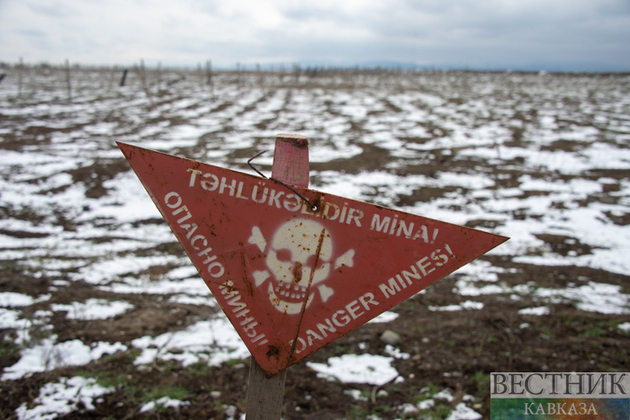The government of Azerbaijan announced its plans to clear 40,000 hectares (around 99,000 acres) of land in the country’s liberated territories from landmines in 2022 under a demining action plan adopted by the Cabinet of Ministers, Caspian News writes.
Rufat Mammadov, Chief of Office of the Cabinet of Ministers, said the mine clearance operations in Azerbaijan would cover twice as many territories in 2022 compared to the previous year. “The main purpose of such rapid demining activities is to create favorable conditions in the liberated territories, to reintegrate the areas into economic turnover, to develop the tourism sector and the mining industry,” Mammadov said, adding that settlements would also be restored and reconstructed for the return of people.
According to Mammadov, an all-new system for demining operations was launched in Azerbaijan’s Aghdam district, polluted with unexploded ordnances more than other liberated territories. “Since these areas are more polluted than the others, we have started to apply an artificial intelligence-based system for aerial mine research. Azerbaijan is one of the first countries to use this solution. This system allows determining the location of mines accurately,” the government official added.
On January 28, Azerbaijan National Agency for Mine Action (ANAMA) introduced a new mobile field camp for sappers in the Aghdam district. It consists of a hostel, a canteen, a laundry, a warehouse, an office, and a first-aid post, as well as special places for keeping mine detection dogs and repairing equipment and vehicles. ANAMA plans to use the camp to expand the scale of mine clearance operations and increase personnel. The mobile container-type camp can be moved to other areas, depending on the location of demining activities.
The Karabakh (Garabagh) region, an internationally recognized territory of Azerbaijan, has been mined heavily during its nearly 30-year-long occupation by Armenia since the early 1990s. Armenia kicked off full-blown military aggression against Azerbaijan following the Soviet Union’s dissolution in 1991. The bloody war lasted until a ceasefire in 1994 and saw Armenia occupying 20 percent of Azerbaijan’s internationally recognized territories. Over 30,000 Azerbaijanis were killed, and one million were expelled from those lands in a brutal ethnic cleansing policy carried out by Armenia.
On September 27, 2020, the decades-old conflict between the two countries spiraled after Armenia’s forces deployed in the occupied Azerbaijani lands shelled military positions and civilian settlements of Azerbaijan. During the counter-attack operations that lasted 44 days, Azerbaijani forces liberated over 300 settlements, including the cities of Jabrayil, Fuzuli, Zangilan, Gubadli, and Shusha, from nearly 30-year-long illegal Armenian occupation. The war ended in a tripartite statement signed on November 10, 2020, by Armenia, Azerbaijan, and Russia. Under the statement, Armenia also returned the occupied Aghdam, Kalbajar, and Lachin districts to Azerbaijan.
Shortly after the war, the Azerbaijani government started extensive mine-clearing operations in the once occupied lands to revive the region and bring the internally displaced persons back to their native lands.
Azerbaijan National Agency for Mine Action (ANAMA) leads the ongoing mine clearance operations in the liberated territories. The agency deployed its specialists and cutting-edge machinery of the Turkish, British, Slovak, and Croatian production there shortly after the hostilities ended in November 2020. Some foreign countries, including France, have announced their plans to provide financial aid to assist mine clearance operations in Azerbaijan. The United Kingdom has allocated half a million pounds for this purpose.
According to data compiled by ANAMA, over the last year, a total of 41,503 landmines of various types and unexploded ordnances had been found and neutralized in 20,165 hectares (around 50,000 acres) of land in the liberated territories. The agency had completed 46 out of 55 mine clearance projects assigned by the government.
In 2021, ANAMA received 20 mine detection dogs under the Memorandum of Understanding signed with the Marshall Legacy Institute (MLI), an American non-profit organization. By 2023, the agency will receive the other ten dogs. In addition, the British Defense Ministry will organize Explosive Ordnance Disposal – Level 3 (EOD3) training courses for 15 specialists from ANAMA. Also, the British Mine Advisory Group (MAG) will reportedly conduct practical and theoretical training for the newly hired supervisors of ANAMA.
Meanwhile, demining operations have faced many challenges due to Armenia’s refusal to hand over the maps of the areas where the landmines are located.
Azerbaijan obtained from Armenia the minefield maps of the once occupied Aghdam, Fuzuli, and Zangilan districts, which reportedly identify the coordinates of a total of 189,000 anti-tank and anti-personnel mines. Armenia has recently provided the Azerbaijani side with mine maps of other liberated territories of Azerbaijan. In exchange for maps, Azerbaijan released dozens of Armenian saboteurs detained in Azerbaijani territory after the ceasefire. However, Azerbaijan’s President Ilham Aliyev said the accuracy of these maps did not exceed 25 percent. Officials in Baku are convinced that the maps hidden by Armenia could help neutralize at least one million landmines planted in the once occupied Azerbaijani lands.
ANAMA officials noted that the neutralization of unexploded ammunition, warheads, and missiles in the combat zones under current circumstances could take 5-6 years, while it is about 10-13 years for the mined areas.






